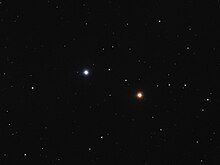Image de ν
1 (étoile orangée à droite) et de
ν2 Bootis (étoile bleue-blanche à gauche)
Désignations
modifier
Nu1 Bootis (ν1 Bootis / ν1 Boo) est une étoile géante de la constellation boréale du Bouvier . Elle est visible à l’œil nu avec une magnitude apparente de +5,02[ 2] a.l. pc [ 1] vitesse radiale héliocentrique de −11 km/s [ 4] extinction créé par la poussière interstellaire présente sur le trajet de la lumière émise par l'étoile[ 11]
ν1 Bootis est une étoile géante rouge de type spectral K4,5 IIIb Ba0,4 [ 3] étoile à baryum [ 12] atmosphère a été enrichie par le processus s en certains éléments qui ont probablement été fournis par un compagnon en orbite qui est désormais devenu une naine blanche [ 13] plus grande que le Soleil [ 6] lumineuse que le Soleil [ 8] température de surface est de 3 917 K [ 7]
↑ a b c d e f et g
(en) A. G. A. Brown et al. Gaia collaboration), « Gaia Data Release 2 : Summary of the contents and survey propertiesAstronomy & Astrophysics vol. 616, août 2018 , article no A1 (DOI 10.1051/0004-6361/201833051 Bibcode 2018A&A...616A...1G arXiv 1804.09365 Notice Gaia DR2 pour cette source sur VizieR .
.
↑ a b c et d (en) H. L. Johnson et al. UBVRIJKL photometry of the bright stars », Communications of the Lunar and Planetary Laboratory vol. 4, no 99, 1966 (Bibcode 1966CoLPL...4...99J ↑ a et b (en) Philip C. Keenan et Raymond C. McNeil , « The Perkins catalog of revised MK types for the cooler stars », Astronomy & Astrophysics Supplement Series vol. 71, octobre 1989 , p. 245 (DOI 10.1086/191373 Bibcode 1989ApJS...71..245K ↑ a et b (en) J. H. J. de Bruijne et A.-C. Eilers , « Radial velocities for the HIPPARCOS-Gaia Hundred-Thousand-Proper-Motion project », Astronomy & Astrophysics vol. 546, octobre 2012 , p. 14, article no A61 (DOI 10.1051/0004-6361/201219219 Bibcode 2012A&A...546A..61D arXiv 1208.3048 ↑ (en) Ricardo P. Schiavon , « Population Synthesis in the Blue. IV. Accurate Model Predictions for Lick Indices and UBV Colors in Single Stellar Populations », The Astrophysical Journal vol. 171, no 1, juillet 2007 , p. 146–205 (DOI 10.1086/511753 Bibcode 2007ApJS..171..146S arXiv astro-ph/0611464 ↑ a et b (en) Tyler E. Nordgren et al. Stellar Angular Diameters of Late-Type Giants and Supergiants Measured with the Navy Prototype Optical Interferometer », The Astronomical Journal vol. 118, no 6, décembre 1999 , p. 3032–3038 (DOI 10.1086/301114 Bibcode 1999AJ....118.3032N lire en ligne ) ↑ a b c et d "(en) Ph. Prugniel , I. Vauglin et M. Koleva , « The atmospheric parameters and spectral interpolator for the MILES stars », Astronomy & Astrophysics vol. 531, juillet 2011 , A165 (DOI 10.1051/0004-6361/201116769 Bibcode 2011A&A...531A.165P arXiv 1104.4952
↑ a et b (en) I. McDonald , A. A. Zijlstra et M. L. Boyer , « Fundamental Parameters and Infrared Excesses of Hipparcos Stars », Monthly Notices of the Royal Astronomical Society vol. 427, no 1, 2012 , p. 343–57 (DOI 10.1111/j.1365-2966.2012.21873.x Bibcode 2012MNRAS.427..343M arXiv 1208.2037 ↑ (en) J. R. De Medeiros et al. Rotation and lithium in single giant stars », Astronomy & Astrophysics vol. 363, novembre 2000 , p. 239–243 (Bibcode 2000A&A...363..239D arXiv astro-ph/0010273 ↑ (en) * nu.01 Boo -- Star sur la base de données Simbad Centre de données astronomiques de Strasbourg ..↑ (en) B. Famaey et al. Local kinematics of K and M giants from CORAVEL/Hipparcos/Tycho-2 data. Revisiting the concept of superclusters », Astronomy & Astrophysics vol. 430, no 1, janvier 2005 , p. 165–186 (DOI 10.1051/0004-6361:20041272 Bibcode 2005A&A...430..165F arXiv astro-ph/0409579 ↑ (en) A. E. Gomez et al. Absolute magnitudes and kinematics of barium stars », Astronomy & Astrophysics vol. 319, 1997 , p. 881 (Bibcode 1997A&A...319..881G ↑ (en) P. P. Eggleton et A. A. Tokovinin , « A catalogue of multiplicity among bright stellar systems », Monthly Notices of the Royal Astronomical Society vol. 389, no 2, septembre 2008 , p. 869–879 (DOI 10.1111/j.1365-2966.2008.13596.x Bibcode 2008MNRAS.389..869E arXiv 0806.2878 lire en ligne )
Liens externes

